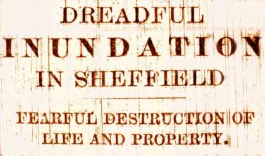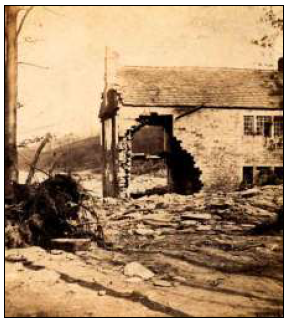
(Image courtesy of Malcom Nunn)
At near midnight on the 11th March 1864, the embankment of the newly constructed Dale Dyke Dam collapsed and 114 million cubic feet of water rushed down into the Loxley Valley and then into the River Don, and through the centre of Sheffield. This flood was the greatest peace-time disaster of Victorian Britain.
In the mid-nineteenth century Sheffield was a rapidly growing industrial town. Its population had increased from 45,748 in 1801, to 185,187 in 1861, and there was a great need for supplies of clean drinking water. Water had originally been supplied by several small reservoirs in the Crookesmoor area to the west of the city centre, and then by more reservoirs built at Redmires in 1836, 1849 and 1854. But demand rapidly outgrew supply and the Sheffield Waterworks Company started the construction of Dale Dyke Dam in Bradfield Dale in 1859. This was completed in 1863 and was allowed to fill with water. By 11 March 1864, just as the reservoir was full, the earth bank of the reservoir failed, releasing an enormous amount of water (690 million imperial gallons) that cascaded down the Loxley Valley, into the River Don and through the densely populated centre of Sheffield.
The wall of water raced down the valley destroying everything in its path, ripping heavy machinery out of its foundations, demolishing buildings, and sweeping away people, livestock, equipment, trees, fences, and walls. All this debris was taken downstream wreaking terrible havoc on Sheffield. The Chief Constable's records of the time show that 240 people were drowned, 100 buildings and 15 bridges were destroyed, and about 4000 houses were flooded. Many businesses were ruined. It is likely that many more people lost their lives from the after effects of the flood, such as disease and injury.
The inquiry afterwards determined that the dam construction was defective and the resulting claims for damages formed one of the largest insurance payouts of the 19th century. There were approximately 7000 claims filed and almost £274,000 in damages was awarded. The claims were enabled by a special Act of Parliament, and mostly heard between November 1864 and August 1865. The Sheffield Flood Claims Archive holds the Registers of Claims, which are a fascinating and unique look into the details of everyday-life, mainly of the poorer classes, of Victorian Britain.
- We have 22 Flood victims buried in the cemetery
- More about the flood: there are books, articles, videos and photographs about the flood listed on this page.
- We have some photos of the flood in our Gallery.

